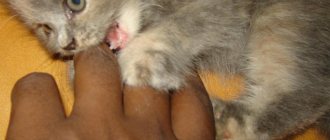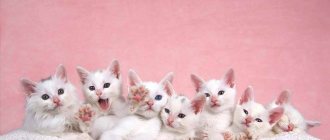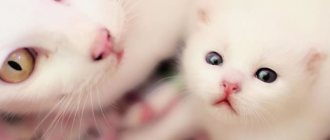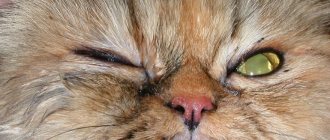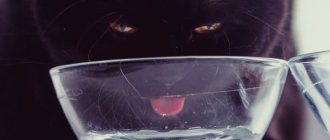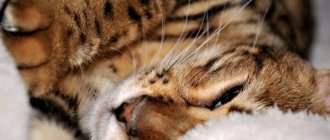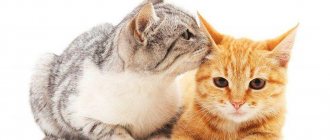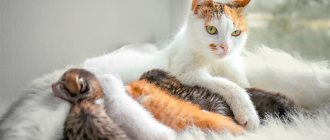What determines the number of kittens in a litter?
First, you should know what factors influence the number of kittens a cat can give birth to. There are many of them, they are very diverse. The main ones are :
- Breed . It has long been noted that the more purebred a cat is, the fewer kittens it will have in one litter. It is not uncommon for a purebred mother to give birth to only one kitten.
- Age when pregnancy began . A young cat, especially if this is her first lambing, will give birth to one to three kittens. The number of babies will be kept within the same limit until the cat is three years old. From the fourth year onwards, sexual activity and reproductive function peak. Accordingly, the litter increases. At the age of 4-6 years, the pet will bear and give birth to from 4 to 12 kittens. After this, a decline sets in, the chances of getting pregnant decrease, and if an interesting period begins, then again, there will most likely be only one kitten.
- Genetic predisposition . A cat's multiple births are almost always inherited. If her mother often gave birth to many kittens, then she will give birth to more than usual.
- Partner's sexual activity . The more active the cat, the greater the chance that the cat will produce numerous offspring.
- And hormonal imbalances and diseases of the genitourinary system significantly reduce both the possibility of prolonging the birth and the number of kittens born.
- The number of times a cat gives birth per year also has a significant impact . Frequent pregnancies exhaust the body, and each subsequent lambing will be smaller and weaker.
- Animal nutrition and weight . With a balanced diet and normal weight, a cat gives birth to 3 to 8 kittens per lamb. Inadequate diet and weight problems, on the contrary, lead to fewer kittens being born. Sometimes infertility occurs altogether.
It turns out that a healthy cat, pregnant for the first time, will give birth to 1-3 kittens. Subsequent litters can number up to 8-12 babies. But by the age of seven, their number will again drop to 2-3 individuals per lambing.
Individual characteristics of a cat
The number of kittens born to a cat depends on a number of factors:
- Age of the woman in labor. From a physiological point of view, it is better when a cat gives birth to kittens for the first time at the age of 1–2 years. Her body is already fully formed and she is able to bear offspring. Young cats usually have a smaller litter size (2-3 kittens) than more mature females. Occasionally, with good care, a young cat can give birth to up to six viable kittens. Adult cats usually give birth to 6–8 babies.
- Breeds. Outbred cats are more fertile than purebred cats.
- Heredity. In cats, hereditary dependence in terms of reproduction is clearly visible. The more fertile the female relatives (mother, etc.), the higher the likelihood of inheriting their reproductive qualities and producing more offspring per lamb.
- Duration of pregnancy. The longer the gestation period lasts, the fewer kittens will be born in the litter.
- Lifestyle.
- Living conditions.
- Food quality.
An important role in how many kittens a cat will have is played by the physiological characteristics of the partner:
- Age. Excessively young or, conversely, old cats have less “productivity”.
- Number and frequency of matings. With increased sexual activity of a cat, the quality of its sperm deteriorates.
- Health. It is important that the future dad does not have diseases of the genitourinary system, as well as infectious diseases.
- Sexuality. In cats, ovulation occurs during mating and the number of eggs produced is influenced by the intensity of the partner’s “courtship.” Interestingly, felines are characterized by superfecundation, i.e. fertilization of eggs with sperm from different individuals. Thus, one litter may contain kittens from different fathers.
How many kittens does a cat bear: ways to determine the number of fetuses
A cat's pregnancy lasts about 65 days. Already in the third week of an interesting position, her tummy becomes rounded. At this stage, the kittens can be felt by lightly massaging the mother's belly. Although veterinarians do not advise doing this in order to avoid negative consequences for both the babies and their mother. There are safer ways to find out how many kittens a cat will have this time :
- Folk - not the most accurate, but safe and simple. You just need to count the number of the cat’s mammary glands and subtract the number 2 from them. The resulting figure means the number of future kittens.
- Medical - veterinarians advise simply giving the cat an ultrasound examination. It is usually prescribed in the second month of pregnancy. Using an ultrasound, you can find out the exact number of kittens without causing harm.
So when the signs of pregnancy in a cat are already visible to the naked eye, you can safely go to the veterinarian, who will refer the expectant mother for an ultrasound. Do not neglect the achievements of medicine, because the health of a domestic cat is very important, especially if she is pregnant.
Length of pregnancy
The normal gestation period for a cat is 65 days, which can also be described as 9 weeks. You can remember this very easily if you draw a parallel with the 9 months of pregnancy in a woman.
If you need to find out how many days a British cat's pregnancy will last, you can use the given figure plus minus 5 days. In long-haired breeds, the variations are much greater - gestation can last from two months to exactly 75 days.
Experienced veterinarians who know how long pregnancy in animals should last say that cats may have several variants of pathologies that should be avoided. Among them are:
- Exhaustion of the body can lead to childbirth before 60 days: in such a situation, the prognosis for the viability of the offspring is negative.
- Severe fright in the last weeks of pregnancy can lead to the fact that birth does not occur until the 70th day, which can lead to pathological changes in the cat’s body.
- In Persian cats with a fearful character, it is very rarely possible to predict how long the gestation period lasts - it all depends on the specific conditions of detention, however, in a stressful environment, a period of 72 days is considered normal.
If you are unsure about the timing of your pregnancy and think the birth is delayed, be sure to contact your veterinarian who can answer all your questions.
When contractions do not begin, although the animal shows noticeable signs of anxiety, they need to be stimulated
Lay your cat on your lap and gently massage her stomach and back. Try to feel the uterus and the kittens inside it
If this condition lasts more than 6 hours, seek medical help.
How many kittens can a cat give birth to?
Many cat owners worry about their pets' fertility. This issue is especially important to owners of rare breeds of animals. Cats are very prolific creatures. The female is capable of bearing and giving birth to kittens constantly. Over the course of a lifetime, a cat can become a mother to almost two hundred kittens. Naturally, this figure is approximate, since a different number of fluffies are born per lamb. Some cats are capable of producing a rich litter of 8–10 kittens. Others are scarce - 2-3 kittens. This depends on various factors of the animal's genetics, biology and environment.
How many kittens can a cat give birth to?
On average, one cat pregnancy can give birth to 6-8 kittens. But there are different indicators. For example, there is a well-publicized case in which a Persian cat named Bluebell gave birth to fifteen kittens at a time, fourteen of which were alive and well.
There are cases of birth of only one or two kittens. It is worth noting here that the birth of one kitten to an adult cat with more than her first pregnancy is a pathology. After such a birth, the cat should be shown to the veterinarian. Perhaps the lambing was unsuccessful, and a dead baby was stuck in the mother’s body. Or the cat has diseases that make it impossible to get normal offspring.
It has been noticed that street cats give birth to much more offspring than their pampered counterparts in apartment conditions. This is due to the fact that in the natural environment more dangers await babies, and it is genetically determined that in order to procreate in such conditions, the offspring must be numerous.
First pregnancy
Statistics show that a primiparous cat will have a small litter. Most often, a pet brings no more than three kittens. This is due to the incompletely formed structure of the genital organs.
A first-time cat usually has no more than three kittens.
The first pregnancy in a cat can occur at the age of 8–9 months, usually by this time the young cat is fully mature. But due to the fact that the body is young and tender, the birth of kittens is a risk factor for the expectant mother. Animals living in nature are uncontrollable. Then natural selection plays its role. But if a cat lives in a house and is looked after by a loving owner, he should not allow mating until the female is at least a year old. It’s better to wait until the age of one and a half years.
Cat in active childbearing phase
The average for a mature cat with more than her first pregnancy is 4–6 kittens. Cats often give birth to 8–10 babies.
Based on the physiology of the cat's structure, the number of kittens should not exceed the number of nipples in the animal. There are eight of them in total. This is an extreme indicator and should be a guideline for any breeder. If there are more than eight kittens, they will begin to experience a clear lack of mother's milk due to lack of space around the nipple. And some of such a litter may die.
An old-time cat, like a young cat, gives birth to few cubs. This is due to wear and tear of the reproductive system.
How does this interesting situation unfold?
Caring owners expecting offspring keep special notebooks to monitor how their beloved cat’s pregnancy progresses. You can make a schedule week by week and note all the changes that occur with your cat. This will make it easier to compare the animal’s current health status with the norms. The table shows the optimal course of pregnancy.
Table - Cat pregnancy by week
| A week | Symptoms | Fruit size, cm |
| 3-4 | - Swelling, darkening of the mammary glands; - toxicosis, manifested by nausea, refusal to eat, morning vomiting; - decreased activity | 4 |
| 5-6 | — Increase in body weight; - rounding of the abdomen; - appearance of milk; - sharp increase in appetite | 6 |
| 7-8 | — Shedding; — active nesting; - decreased appetite; - movement of kittens | 9,5 |
| 9-10 | — Decreased activity, apathy; - noticeable enlargement of the mammary glands; - discharge of clear mucus from the vulva; - decrease in body temperature to 37°C | 12,5 |
Just before giving birth, the cat is active. The pet follows its owner, meows, and fusses in the area designated for lambing. The cat's figure becomes pear-shaped: the roundness moves towards the exit of the uterus. There are spasms - contractions. Having noticed these signs, the owner should prepare for childbirth.
Superfetation
During the third to sixth week of pregnancy, a cat may begin to undergo a planned estrus. This happens to one in ten pregnant cats and is considered normal in urban apartments. The body, which receives all the benefits for a happy life (light, warmth, food), “ignores” pregnancy and is ready to mate. This happens due to hormonal imbalance, namely due to a lack of progesterone, which is responsible for bearing offspring.
If your cat often licks her genitals or behaves restlessly, test for the presence of estrus. Apply a tissue to your vulva. If there are transparent spots left on it, the cat has flown.
There is no reason to worry, you just need to protect the expectant mother from potential sexual partners. Otherwise, re-fertilization will occur, which can result in one of three situations:
- miscarriage - both the “older” and “younger” offspring die;
- prematurity - the first kittens are born healthy, the second - premature or dead;
- repeat birth - three to six weeks after the first birth, the cat gives birth again (rarely happens).
The most favorable outcome for a cat is to give birth to healthy kittens from both fathers. However, the mother has a limited number of nipples, and the offspring from the second fertilization may die of starvation.
False pregnancy
It happens that symptoms of pregnancy appear, but the cat does not give birth. This is a false pregnancy. In fact, fertilization has not occurred, but the pet behaves like a future mother. Her shape becomes rounder, her mammary glands swell, and her appetite changes.
The cat begins to build a nest, becomes irritable or, conversely, quiet and calm. An imaginary pregnancy is clearly expressed in the “adoption” of slippers, socks, and mittens. The cat can carry things around the apartment like cubs, and even feed milk.
False pregnancy in cats is not a whim or a game of “mommy”, but a serious mental illness associated with hormonal imbalance. It appears in both mated and chaste pets. Siamese and Persian cats are prone to false pregnancies. Possible causes of hormonal imbalance are:
- stress, emotional shock;
- stimulating ovulation in a castrated cat;
- infectious diseases of the reproductive organs;
- pathologies of the thyroid gland;
- attention deficit;
- proximity to pregnant and lactating cats;
- heredity.
The disorder is treated with a low-calorie diet (milk production decreases) and medications prescribed by a veterinarian. Without treatment of false pregnancy, a cat may develop mastopathy. This is a disease of the pet's mammary glands, which leads to malignant tumors. Also, an imaginary pregnancy, left to chance, will have a bad effect on the psyche, character and behavior of the animal.
To protect your pet from mental and physiological disorders, it is necessary to carry out timely diagnosis of pregnancy. The easiest way to verify the presence of offspring is with an ultrasound, which can be done as early as the third week.
How to determine how many kittens are in the womb
There are several ways to tell the owner how many babies the pet will bring:
- Genetics. You need to look at the number of kittens born to the mother of a pregnant pet. A cat's fertility is reflected in its offspring. For example, if the mother of a pregnant cat brought 8 kittens at a time, then this individual will have the same number. If this figure was reduced to two or four, then you should not expect a large offspring.
- Folk wisdom. Experienced breeders use a simple counting method. The total number of mammary glands of the female is taken into account (not all nipples, but precisely those glands that swelled during pregnancy) and subtracted by two. This method cannot guarantee 100% results. However, it is often applicable.
- The science. Veterinarians and felinologists advise checking the expectant mother cat using modern technology, for example, an ultrasound examination. The time for the procedure is scheduled approximately a week before the expected lambing. This method will give an exact figure for the future offspring.
Ultrasound examination can show the exact number of kittens
You should not try to determine how many kittens are in a cat’s belly by palpating. This can harm the embryos and cause stress in the animal.
Video: analysis of a horary chart - how many kittens a cat will have
Safe methods to increase cat fertility
When the cat is purebred and the owners are planning breeding, the question arises of increasing the birth rate. Designing the scale of offspring is not a simple matter, because it involves interfering with the natural processes of the body. The main task here is not to harm the animal.
Naturally, you can’t do without medications:
- Today's veterinary market offers a lot of homeopathic products that do not harm your beloved pet. Among them, Gamavit and Ovariovit received excellent recommendations. These drugs are designed to restore the function of the reproductive system, affecting the formation of a large number of eggs.
Ovariovit is a homeopathic drug for the prevention and treatment of ovarian dysfunction in cats, increases fertility, reduces the risk of false pregnancies
The stimulation process must begin long before mating. If pregnancy has taken place, all manipulations will be meaningless.
Small and multiple pregnancy of cats - which is better
It is rare to find a breeder who welcomes a cat to become pregnant with a large litter. Multiple pregnancy is fraught with numerous adverse consequences. This is unsafe for the tailed mother, and the financial aspect matters. Before kittens find a new home, they need proper care, and this includes costs for food, hygiene products, and litter.
Multiple pregnancy exhausts a cat
A large number of cubs (let’s imagine that 10 of them were born) tires the mother, “squeezing all the juice out of her.” The female is unlikely to be able to feed them on her own.
I have personally experienced the adverse effects of a large number of kittens on a nursing cat. My two cats gave birth 2 days apart. Between them they had 7 kittens, and they coped with them quite well. But two weeks later I took in the foundlings - three newborn kittens abandoned by someone. The cats accepted them immediately. It seemed that the number of kids (ten) between two was quite acceptable, but I noticed that the cats began to lie in the box one at a time. One of the foundlings had to be fed additionally - he simply did not have enough space at the nipple, and he could not get to it on his own due to weakness. By the time all the kittens were feeding on their own, my cats were like walking skeletons, even though I fed them well given their circumstances. So I came to the conclusion that many kittens, even if the cat has no problems with lactation, is not very good for both the mother and the babies.
Multiple pregnancies often end in stillborn kittens, since the cat’s physiology cannot cope with the large volume of embryos.
A low-fertility pregnancy, in turn, can lead to the baby getting stuck in the birth canal, because usually the kittens in such litters are quite large. This will lead to an emergency cesarean section (in the best case, if the owner starts sounding the alarm in time, in the worst case, the cat may die, like her baby). Excess unclaimed milk contributes to the development of mastitis, which also has a risk of unfavorable developments.
The best option for a cat is the golden mean, that is, 4–6 kittens.
It is worth understanding that the most important thing is not the number of kittens born, no matter how expensive they may be, but the health of the cat and her offspring. Procreation is an amazing process gifted by nature. You should not interfere with its laws. You just need to help the animal in this difficult matter.
Cat giving birth
If you notice that the mammary glands on the cat’s stomach are swollen, she also has white discharge, the animal refuses food and strives to hide in its “nest” - all these are clear harbingers of childbirth. In healthy animals this period lasts at least a day. It is typical that animals that lead a passive lifestyle and suffer from obesity have a more difficult birth, so do not try to overfeed your cat during pregnancy.
How does a cat give birth?
On average, a cat's labor can last up to 24 hours. However, if the animal cannot give birth on its own even on the second day, it is recommended to immediately seek help from a veterinarian.
At first, the cat begins to have rare contractions, then their frequency increases, and the time intervals between them decrease. The active phase of labor - the birth of kittens can last from 2 to 6 hours, depending on the intensity of labor. The kittens themselves are usually born at intervals of 10-15 minutes. The cat breaks the amniotic sac around the kitten so that it does not suffocate (sometimes the amniotic sac is already ruptured), licks the newborn kitten, and gnaws its umbilical cord. After the birth of a kitten, a placenta follows it
Please note that the number of afterbirths must correspond to the number of newborn kittens, and if the afterbirth for some reason does not come out, this can cause a serious complication. In this case, it is also recommended to seek help from a veterinarian
As a rule, the cat eats the afterbirth itself.
Cat behavior during childbirth
During childbirth, the instincts laid down by Nature are triggered in the cat’s body, therefore, even a cat who gives birth for the first time knows how and what to do. However, there are situations when the animal panics and begins to rush around the room - these are the consequences of painful shock. In this case, you need to put the cat in a box and talk to it tenderly, stroke its head and calm the animal. After all, her state of panic and fear blocks the natural processes that are now occurring in her body.
As a rule, cats always lick newborn kittens, however, if you notice that this does not happen, you should be wary and make sure that the cat does not eat its newborn offspring. Why cats do this - you can read here. In this case, you will have to look for another mother cat for the babies, since the chances that you will feed them and go out on your own are negligible.
How to help a cat during labor
If you are not a veterinarian, then it is unlikely that you will be able to provide qualified medical care to an animal. But it’s within your power to take care of her in advance, especially if the pregnancy is accompanied by complications, and to agree with the veterinarian that he will come to your home when the cat goes into labor.
If there are no prerequisites for anxiety, your best help is moral support for the animal, but only if the cat asks for it. If an animal drives you away, you should not impose your company on it. Be that as it may, this is also a small miracle - the birth of kittens, and the cat wants it to pass without unnecessary witnesses.
If you see that labor is protracted, contractions are unproductive, and the cat is exhausted, it is still better to seek help from veterinary specialists.
Normal number of kittens in a litter
The question of the number of babies in the litter has practical significance for the owner of a pregnant female: it allows you to simplify obstetric care and have an idea in advance about how many babies need to be placed in good hands.
Many years of experience in keeping domestic cats indicates that the average pet living in favorable conditions gives birth to 4 to 6 kittens. Of course, this figure may change in one direction or another, but the deviation is insignificant.
It is not uncommon for a cat to give birth to 10 or even 15 live cubs per lamb, but this is rather an exception to the rule. It is difficult to guess how many kittens a cat can give birth to. Experienced breeders believe that the size of the offspring depends on the number of milk nipples the female has. To do this, you need to count them and subtract the number 2. This method of determination is not absolutely reliable, but can be adopted.
Physiologically, the size of the offspring is determined by the number of sites where fertilized eggs attach to the walls of the uterus, which in cats consists of two horns. Therefore, young and old females give birth to fewer kittens than animals at optimal reproductive age.
Many factors influence how many kittens a cat can give birth to:
- Age of the expectant mother. Firstborns most often give birth to 1 to 3 babies maximum. Fertility in an old animal decreases. After the age of seven, the pet will produce fewer cubs than a cat under the age of 6-7 years. The peak of multiple births (from 4 to 12 babies per lamb) occurs at the age of 3 to 6 years.
- Heredity. If females in a cat’s family have produced numerous offspring, then there is a high chance that the animal will also have multiple births.
- The reason why a cat gives birth to few kittens is often a hormonal imbalance, leading to a decrease in the synthesis of eggs ready for fertilization.
- Breed. There is a tendency: a purebred animal gives birth to fewer kittens than a purebred animal, and rarely produces more than 5 babies in one lamb.
Features of pregnancy and preparation for childbirth
Pregnancy in cats lasts on average 63-65 days. By the middle of the term, a noticeable belly grows. When stroking, you can feel that it is dense and slightly elastic. After another week, the fruits can already be felt a little. It is better to entrust this to a doctor, because under no circumstances should you press too hard or for too long. At this stage, the kittens are already beginning to descend into the lower abdomen.
Over the course of 6-7 weeks, the belly grows a little more, and the mother begins to prepare for childbirth. Now, if you put your hand on her stomach, you will clearly feel something moving inside. From the 8th week until the birth, the mother cat no longer has the strength to move, so make sure that she has a quiet and calm place somewhere in a wide basket or box. Bring her food and water.
During childbirth, you can help your pet by lightly stroking her belly from top to bottom. But in general, childbirth goes quickly and without complications. After it's all over, leave her alone with the kids.
Do you like the article? 503
How many days does a cat bear offspring?
Experienced owners have an idea of how many kittens a cat carries. The average duration of pregnancy is 59 - 64 days. Representatives of large and long-haired breeds bear babies longer - up to 70 days. Postmaturity has more negative consequences than giving birth prematurely. Therefore, if you suspect that pregnancy is prolonging, you should show the animal to a veterinarian.
The duration of pregnancy is influenced by various factors: nutrition and maintenance of the animal, health status, stress, individual characteristics. The number of developing fetuses also influences how long a cat carries kittens in her stomach. If there are 1 - 2 kittens in the womb, then the mother carries them longer than in the case of a large litter.
2 - 3 days before giving birth, the cat becomes restless and looks for a quiet and secluded place. By this time, the owner should prepare a cozy and clean nest for the future mother in a quiet, darkened room. Shortly before labor begins, the animal loses its appetite. When you press on the nipples, drops of colostrum appear. A characteristic sign of approaching labor is a decrease in body temperature to 37 C.
If the animal is healthy, then the birth takes place independently and the owner can only observe and, if necessary, unobtrusively provide assistance to the pet. In case of complications during labor, you should immediately seek help from a veterinarian.
Feeding a pregnant cat
It is necessary to feed a pregnant cat, as well as a non-pregnant one, with high-quality food. Nutrition should be balanced and individually selected, taking into account breed characteristics, body weight and the presence of chronic diseases before pregnancy.
Your cat should be at a normal weight for her breed and age. Its deficiency or excess can negatively affect its reproductive function.
Food for pregnant cats may already be prepared. Some owners who prefer to feed their pets natural food should additionally enrich the cat’s diet during the period of gestation with special vitamin complexes and mineral supplements.
In the initial stages of a pet’s pregnancy, it is recommended not to change eating habits, as this can provoke developmental disorders in future babies. It is not advisable to give vitamins to pregnant cats from weeks 1 to 3, especially if the animal is on a high-quality diet.
As the fruits develop, at about 4-5 weeks of gestation, the animal’s appetite increases and the fruits increase in size. Feed manufacturers, as well as veterinarians and breeders, recommend not increasing the daily dosage of food, as this can lead to risks of obesity.
But the increased need for proteins and lipids must be satisfied. Dairy products are great for these purposes, but not fish. During this period, cats on dry food transition well to food intended for kittens and lactating cats. This will help you avoid stress later after the babies are born.
You need to properly care for a pregnant cat. Overfeeding a pet should not be allowed, as increased body weight leads to obesity and complications during the birth process. Your pet should always have access to food and clean drinking water.
Before the expected pregnancy begins, the animal must also be well-groomed and in a normal weight category. This allows you to avoid quite serious changes in the body of developing fetuses.
When choosing special food for a cat during pregnancy, the owner should pay attention to such features as the brand of food and the presence of taurine in the composition. In addition, the composition of super-premium feed should be as balanced as possible in terms of beneficial lipids and proteins
The total magnesium content in the feed should be about 0.08%.
Color of kittens and their number in subsequent litters
Owners of domestic cats often wonder why cats give birth to different kittens. To understand this issue, you need to have an understanding of the characteristics of ovulation in cats and the basics of feline genetics. Experienced breeders, using special color calculators and tables, can plan the desired color of future kittens, selecting potential parents as carriers of a particular gene.
Most often, cubs of the same color are born in one litter. This is typical for purebred cats during planned mating under the control of the owner. If the cat is of a different color in the next heat, then the kittens will be different in color from the previous litter.
If the cat mated chaotically, then there is a high probability that males of different colors took part in fertilization. Since ovulation in cats occurs at the time of sexual intercourse, the birth of kittens in the same litter of different colors from different fathers is common.
Fertility of different breeds
Typically, a cat gives birth to 6–8 kittens during one pregnancy. Records also happen. There is a known case when a Persian cat was able to give birth to 15 kittens at once. However, with a large litter, there is a high probability of dead or non-viable babies. Newborns have too little body weight and, moreover, the cat does not have enough milk to feed large offspring.
The record holder for the number of kittens is a tabby cat from the USA. She gave birth to 420 furry babies. This is the absolute maximum.
It is also interesting to know what kind of offspring cats of different breeds have. For example, a purebred Scottish cat can give birth to 2-3 babies. A larger number (up to will be if the father is not purebred.
For example, a purebred Scottish cat can give birth to 2-3 babies. A larger number (up to will be if the father is not purebred.
British cats have a higher average fertility. A cat usually gives birth to 4–5 kittens per lamb. But not every representative of this breed can give birth to the maximum.
Methods for determining the number of fruits
A responsible breeder, as a rule, wants to know exactly the number of future babies a pet will have. How to determine how many kittens a cat will have? Some experts claim that the number of future babies can be determined by the number of nipples the mother has. However, this method is not accurate. Feeling the cat's abdomen to determine the number of fetuses is an unsafe technique for the pet's health and is not informative. Even a veterinary specialist needs to be very highly qualified in order to accurately determine the number of future offspring in this way and not harm the babies and mother. Palpation is most often carried out on 20 - 21 days after mating or on the 49 - 55th day. These dates are due to the fact that after the 21st day the uterus is filled with amniotic fluid, making diagnosis much more difficult.
The safest and most informative method for the expectant mother is an ultrasound examination of the uterus. An ultrasound can be performed to determine the number of kittens starting from the 21st day after mating. By this period, you can determine the number of fetuses in the womb and listen to their heartbeat.
A responsible breeder is rightly puzzled by the question of how to find out how many kittens a cat will have. This allows him to competently approach issues of assistance during childbirth and solve the problem of selling young animals in advance. Knowledge of the causes and factors influencing multiple pregnancy, knowledge in the field of genetics will help you choose the right stud cat for your pet, follow the rules of feeding and keeping the animal during pregnancy.
Is it better to have a little or a lot?
Definitely, every owner wants his purebred pet to produce as many furry babies as possible. But it is important to observe moderation - the more fetuses in the womb of an animal, the higher the likelihood of complications during childbirth. This is especially true for young individuals and those who are already aged.
Even a healthy cat is unlikely to be able to feed a litter that is too large. Not only will the babies squeeze all the juices out of it, but there is also a high probability that there will not be enough mother’s milk for everyone. Too much pregnancy often leads to the death of part of the litter in the womb, because the cat’s body cannot cope with such a colossal load.
If a mother gives birth to only a few babies, this risks one of them getting stuck in the birth canal, from where it is usually pushed out by a whole line ready to be born. The fact is that kittens born alone or with 1-2 brothers are an order of magnitude larger than usual. If such an incident occurs, the mother needs an urgent caesarean section, otherwise she may die along with the baby. Excess milk in the glands can also lead to unfavorable events - for example, mastitis.
Of course, the golden mean is the ideal option. It is much better if a pet gives birth to 4-6 healthy ones than 10 weak babies that she cannot even feed. For the most purebred representatives, their own health is much more important than the excessive number of litters - after all, if any serious problems arise, there may be no offspring at all.
How many kittens can a cat give birth to?
Cats reach sexual maturity at approximately 8-9 months. And before the age of 1 year, she is already able to become pregnant and bear offspring. However, experienced breeders understand that this is quite early, and consider such births to be risk factors, since the body is still too young.
Note to the owner! It is not recommended to breed domestic cats under 1 year of age, although in the case of backyard dwellers we cannot in any way influence this fact. It is advisable to wait until the cat is one and a half years old, when the cat’s body is stronger and ready to bear healthy offspring.
What determines the number of kittens?
The number of kittens in a litter is influenced by many factors:
- Firstly, this is the age of the cat. Firstborns most often give birth to a maximum of three cubs. Fertility also decreases in fairly mature females. After the age of seven, a cat gives birth to fewer babies than before the age of 6-7 years. The peak of large families (from 4 to 12 babies per litter) occurs between the ages of 3 and 6 years.
- Heredity also affects possible fertility. If the cat's ancestral ancestors produced numerous offspring, then most likely your animal will be fertile.
- The reason for the small number of kittens is often a hormonal imbalance, which leads to a decrease in the synthesis of eggs ready for fertilization.
- Breed also matters. A trend has been noticed: a purebred cat gives birth to fewer kittens than a mongrel yard animal, and rarely gives birth to more than 5 babies at a time.
- Obesity or, conversely, exhaustion reduces the possible number of offspring.
- A lot also depends on nutrition. If a cat does not get enough protein, taurine, vitamins and minerals, she may develop nutritional infertility (infertility). A meager diet leads to the fact that the animal’s defensive reaction to the lack of certain substances is the fertilization of a small number of eggs.
- Chronic inflammatory processes of the reproductive system negatively affect the cat's reproductive function and can cause the cat to become infertile.
- Another reason for the birth of a minimum number of kittens can be long-term and indiscriminate use of hormonal drugs, such as Counter-Sex, Sex-Barrier. Hormone-based contraceptives seriously undermine the reproductive function of the animal, causing hormonal stress in the body. And this, in turn, leads to the birth of a maximum of 1-2 babies in the litter.
The male also contributes to the number of offspring. During sexual intercourse, a temperamental cat releases a larger number of eggs for fertilization. In addition, the quality of sperm also matters.
Thus, the number of kittens in a litter is influenced by a variety of factors, and it is not always possible to take them into account.
Minimum and maximum
Surely your cat periodically gives birth to 4 to 6 kittens - this is the average for representatives of all breeds. There are also cases of the birth of 8 or more cubs. The fact is that a furry mother has a certain limit - a certain number of babies that she can feed. Their number should not exceed the number of her nipples. If there are more than eight kittens, one will not get milk, which means the baby may die. Then the owners will have to help the young mother feed her offspring.
The minimum number of kittens is one; there are cats that, due to genetic and physiological characteristics, are not able to conceive and bear a large number of fetuses. If your cat usually gives birth to around five babies and suddenly gives birth to one, you should take her to the vet - there is most likely something wrong with her health.
How many kittens can a cat give birth to maximum? It’s hard to say, the known documented limit is 15 pieces. But in general, the number of kittens over 10 is already rare. In purebred animals, the threshold is even lower - they rarely reproduce more than 6 kittens.
An older mother will no longer give birth to the same large litter as in her best years. The reproductive system wears out over time, and the likelihood of a difficult pregnancy increases. It is better to protect your cat from mating after reaching 8-10 years of age.
Is it possible to increase the number of kittens in a litter?
This question is usually of interest to breeders involved in breeding kittens for sale, since the expected profit depends on the number of offspring, as well as covering the financial resources spent on mating (treatment, testing, raising, feeding).
Depending on the regalia of the inseminating cat, the cost of mating can reach up to 10 thousand rubles. At the same time, owners of males are often not interested in the number of offspring. They receive money for mating, and the rest does not concern them. This position is fundamentally wrong: both parties should be interested in a good offspring. Before you give money for mating, ask:
- how often the cat is used;
- is he eating well? whether he has diseases of the genitourinary system;
- how many kittens are usually born from a male cat;
- Does the cat suffer from cryptorchidism?
To increase fertility, experts recommend injecting cats with the following drugs before breeding:
- Ovariovit: a homeopathic medicine that restores ovarian function, regulates the sexual cycle and increases fertility.
- Gamavit: anti-stress, immunostimulating drug, supports the vitality of the body, has a positive effect on eggs.
- Vitamin E: has a beneficial effect on the reproductive system, prevents infertility.
There is a special scheme designed for 10 days, which is often used for cats:
- Ovarium: 0.5 cc is administered subcutaneously once a day.
- Ortilin: 1 tablet twice a day.
- Ovariovit: 1 tablet 2 times a day.
- Vitamin E: 1 capsule twice a day.
- Gamavit: 1 cube per day subcutaneously.
- Catozal: 1 cube per day subcutaneously.
Treatment worsens signs of estrus and increases hormone levels. At the same time, the cat becomes more active and attractive to the inseminator.
Attention! Please consult your veterinarian before using this regimen for your cat.
You can also stimulate a cat by administering B vitamins to it for 2-3 days before mating, which have a positive effect on the activity and endurance of the male’s body.
How to determine the number of future kittens?
Some breeders claim that the exact number of future cubs is indicated by the number of milk nipples in the mother. However, the reliability of this method has not been proven.
Veterinarians sometimes palpate a cat’s belly to determine the size of the litter, but this technique cannot be called safe for the health of the animal. Palpation is most often carried out at 20 - 21 days or 49 - 55 days after mating. The timing is due to the fact that after the 21st day the uterus fills with amniotic fluid, which complicates diagnosis.
Ultrasound examination of the uterus is considered the safest and most informative method. An ultrasound can be performed to determine the number of future kittens starting from the 21st day after mating. By this period of pregnancy, you can determine the number of babies in the mother’s womb and listen to their heartbeat.
A serious and responsible breeder is always puzzled by the question of the number of kittens in a cat’s litter. This information allows him to competently approach the birth process and resolve the issue of selling young animals in advance. Understanding the causes and factors influencing a cat’s fertility and knowledge in the field of genetics will allow you to choose the right inseminator for your mustachioed pet and follow the rules of feeding and keeping her during pregnancy.
